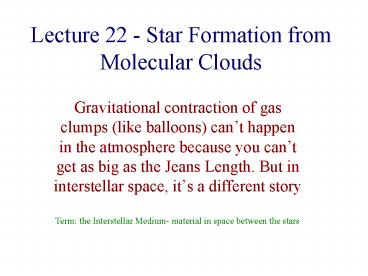Lecture 22 Star Formation from Molecular Clouds PowerPoint PPT Presentation
Title: Lecture 22 Star Formation from Molecular Clouds
1
Lecture 22 - Star Formation from Molecular Clouds
- Gravitational contraction of gas clumps (like
balloons) cant happen in the atmosphere because
you cant get as big as the Jeans Length. But in
interstellar space, its a different story
Term the Interstellar Medium- material in space
between the stars
2
A Star is born.
3
A Star is born (Part 2)
4
Forming stars eventually rip up the molecular
cloud in which they formed. The molecular cloud
is dissipated after about 30 million years. (How
can we know that?)
5
Star formation and the conservation of angular
momentum
6
You can see these phenomena in stars in the sky
(T Tauri stars, Herbig-Haro objects, etc)
jet
Accretion disk
7
Question
- We see these processes occurring in young
protostars. - We understand the physics of these processes (at
least partially) - We believe the Sun formed like this.
- What characteristic of the solar system can we
see that is an indicator of the processes of
contraction, jet formation, accretion disk
formation, etc?
8
Young Stars with Accretion Disks
Beta Pictoris
Fomalhaut
9
Artists Conception of Fomalhaut System
10
Summary of what we know about the formation of
stars
- Stars form from the massive amounts of material
in cold, dark molecular clouds - Contraction from the low density molecular cloud
to a dense, compact, shining star occurs through
gravitational contraction (Jeans Length) - As the star contracts and spins up, it sheds a
disk of matter, from which planets form.
11
Where do we see this occurring?
- Everywhere in the sky. Particularly in the Milky
Way. Check the Skalnate Pleso charts for Taurus
and Auriga
PowerShow.com is a leading presentation sharing website. It has millions of presentations already uploaded and available with 1,000s more being uploaded by its users every day. Whatever your area of interest, here you’ll be able to find and view presentations you’ll love and possibly download. And, best of all, it is completely free and easy to use.
You might even have a presentation you’d like to share with others. If so, just upload it to PowerShow.com. We’ll convert it to an HTML5 slideshow that includes all the media types you’ve already added: audio, video, music, pictures, animations and transition effects. Then you can share it with your target audience as well as PowerShow.com’s millions of monthly visitors. And, again, it’s all free.
About the Developers
PowerShow.com is brought to you by CrystalGraphics, the award-winning developer and market-leading publisher of rich-media enhancement products for presentations. Our product offerings include millions of PowerPoint templates, diagrams, animated 3D characters and more.

